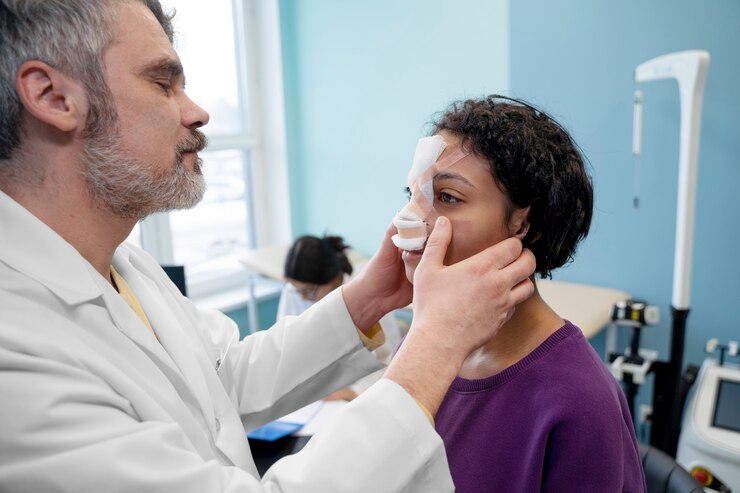Understanding the Nasal Valve: Its Impact on Nasal Obstruction and Treatment Options

Introduction:
Have you ever experienced difficulty breathing through your nose, especially when engaging in physical activities or during sleep? If so, it's possible that the issue could be related to a condition called nasal obstruction. In this blog post, we will explore the concept of the nasal valve, its role in nasal obstruction, and various diagnostic and treatment options available for alleviating this condition. Many people have heard terms like septal deviation, turbinate hypertrophy, allergic rhinitis as the like. Not many people have heard of nasal valve collapse or how it may affect nasal breathing.
What is the Nasal Valve?
The nasal valve refers to the narrowest part of your nasal passages. Anatomically its located internally where the upper lateral cartilage and septum meet. It plays a crucial role in maintaining proper airflow during breathing by regulating the amount of air that enters the nasal passages. In other words, the nasal valve acts as a gatekeeper, allowing air to flow through while preventing excessive resistance or obstruction.
The Importance of the Nasal Valve in Nasal Obstruction:
The overall issue with the nasal valve is the relative rigidity of the sidewalls of this valve. When the tissue that makes up your nose is floppy it causes a collapse of these tissues when you try to breathe in through the nose. When the sides of the nose tend to collapse inward during inspiration, even a small amount, it can cause moderate to severe obstruction. Nasal obstruction can occur due to a variety of reasons, including structural abnormalities, allergies, nasal polyps, or even prior nasal surgeries.

Diagnosing Nasal Valve Dysfunction:
To diagnose nasal valve dysfunction, a healthcare professional will perform a thorough evaluation, which may include: I published a detailed study on the best way to diagnose and evaluate nasal valve issues prior to surgery. You can read about it here if interested. https://pubmed.ncbi.nlm.nih.gov/21825100/
1. Medical History: All physicians will inquire about your symptoms, medical history, and any previous nasal procedures or trauma.
2. Physical Examination: The doctor will visually examine your nasal passages, a CT scan will likely be used to understand the structure of the nasal airway, sinuses and other structures in the nasal airway, also a flexible nasal endoscopy will likely be done, which involves the insertion of a small, flexible tube with a camera into your nostrils. This allows them to assess the nasal structures and identify any abnormalities. The most important evaluation is with the end of wooden qtip inserted into the nasal passage and used to support the nasal valve during inspiration. This can help determine if fixing the nasal valve is worthwhile.
Treatment Options for Nasal Valve Dysfunction:
Several treatment options are available to address nasal valve dysfunction. The appropriate choice depends on the severity of the condition and its underlying cause. Here are some common options:
1. Nasal Implants (Latera):
If the nasal valve collapses during inspiration, nasal implants inserted into the sidewalls can help to make the sidewalls more rigid and collapse less. These internal devices help prevent the collapse that causes the sensation of nasal obstruction. I have done over 1200 of these insertions. They are simple to perform and easy to recover from with no downtime from work. There are very few side effects when properly placed by an experienced professional. The Latera implant can be a very effective way to deal with nasal valve issues without much risk. There are a few insurance companies that pay for these but cash prices are also available for those who wish to pay outside of insurance. Latera does not cause much appreciable change to the appearance of the nose.
2. Thermal Devices:
There are a few devices which use various forms of energy to cause some of the bodies healing mechanisms to increase the amount of collagen in the nasal sidewalls and therefore increase rigidity. The Rhinaer device is one such energy delivery method. The downtime is pretty low but it can cause some swelling and crusting for a few days. Like the latera implant it doesn’t cause appreciable changes to the appearance of the nose.
3. Surgical Options:
In cases of severe nasal valve dysfunction or when conservative measures are ineffective, surgical intervention may be considered. The type of procedure will depend on the specific condition and needs of the individual. These surgical options may include:
- Nasal Valve Reconstruction: This procedure aims to strengthen and widen the nasal valve using various techniques like rib cartilage grafts, sutures, or nasal implants.
- Septoplasty: If a deviated septum is contributing to nasal obstruction, septoplasty can be performed to correct it. This surgery straightens the septum, improving airflow through the nasal passages.
- Turbinate Reduction: Enlarged nasal turbinates can cause nasal valve congestion. Surgery to reduce their size can help improve nasal airflow.
It is essential to consult with an otolaryngologist (ear, nose, and throat specialist) to discuss which surgical option, if any, is suitable for you.
Conclusion:
Nasal obstruction can significantly impact your quality of life, making it essential to understand the role of the nasal valve in this condition. Whether you explore non-surgical options like nasal dilators or topical steroids, or consider surgical interventions such as nasal valve reconstruction or septoplasty, it is crucial to work closely with a healthcare professional to determine the best course of action.
Remember, each individual's case is unique, and a customized treatment plan should be developed based on a thorough evaluation of your symptoms and medical history. By taking proactive steps and seeking appropriate treatment, you can alleviate nasal valve dysfunction and restore comfortable nasal breathing for a better quality of life.
